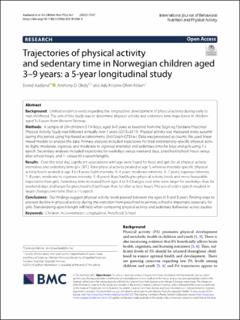| dc.contributor.author | Aadland, Eivind | |
| dc.contributor.author | Okely, Anthony David | |
| dc.contributor.author | Nilsen, Ada Kristine Ofrim | |
| dc.date.accessioned | 2023-03-01T13:01:53Z | |
| dc.date.available | 2023-03-01T13:01:53Z | |
| dc.date.created | 2022-09-13T20:03:06Z | |
| dc.date.issued | 2022 | |
| dc.identifier.citation | International Journal of Behavioral Nutrition and Physical Activity. 2022, 19 (1):67. | en_US |
| dc.identifier.issn | 1479-5868 | |
| dc.identifier.uri | https://hdl.handle.net/11250/3055015 | |
| dc.description.abstract | Background
Limited evidence exists regarding the longitudinal development of physical activity during early to mid childhood. The aim of this study was to determine physical activity and sedentary time trajectories in children aged 3‒9 years from Western Norway.
Methods
A sample of 294 children (51% boys; aged 3‒5 years at baseline) from the Sogn og Fjordane Preschool Physical Activity Study was followed annually over 5 years (2015‒2019). Physical activity was measured every autumn during this period using hip-based accelerometry (ActiGraph GT3X+). Data was processed as counts. We used linear mixed models to analyse the data. Primary analyses included trajectories for total and intensity-specific physical activity (light, moderate, vigorous, and moderate to vigorous intensity) and sedentary time for boys and girls using 1-s epoch. Secondary analyses included trajectories for weekdays versus weekend days, preschool/school hours versus after school hours, and 1- versus 60-s epoch lengths.
Results
Over the total day, significant associations with age were found for boys and girls for all physical activity intensities and sedentary time (p < .001). Total physical activity peaked at age 5, whereas intensity-specific physical activity levels peaked at age 3 to 8 years (light intensity: 3–4 years; moderate intensity: 4–7 years; vigorous intensity: 7–8 years; moderate to vigorous intensity: 5–8 years). Boys had higher physical activity levels and more favourable trajectories than girls. Sedentary time increased from ages 3 to 9. Changes over time were larger for weekdays than for weekend days and larger for preschool/school hours than for after school hours. The use of a 60-s epoch resulted in larger changes over time than a 1-s epoch.
Conclusions
Our findings suggest physical activity levels peaked between the ages of 3 and 8 years. Finding ways to prevent decline in physical activity during the transition from preschool to primary school is important, especially for girls. Standardising epoch length will help when comparing physical activity and sedentary behaviour across studies. | en_US |
| dc.language.iso | eng | en_US |
| dc.publisher | BMC | en_US |
| dc.rights | Navngivelse 4.0 Internasjonal | * |
| dc.rights.uri | http://creativecommons.org/licenses/by/4.0/deed.no | * |
| dc.title | Trajectories of physical activity and sedentary time in Norwegian children aged 3–9 years: a 5-year longitudinal study | en_US |
| dc.type | Peer reviewed | en_US |
| dc.type | Journal article | en_US |
| dc.description.version | publishedVersion | en_US |
| dc.rights.holder | © The Author(s) 2022. | en_US |
| dc.source.volume | 19 | en_US |
| dc.source.journal | International Journal of Behavioral Nutrition and Physical Activity | en_US |
| dc.source.issue | 1 | en_US |
| dc.identifier.doi | 10.1186/s12966-022-01286-0 | |
| dc.identifier.cristin | 2051426 | |
| dc.source.articlenumber | 67 | en_US |
| cristin.ispublished | true | |
| cristin.fulltext | original | |
| cristin.qualitycode | 2 | |

